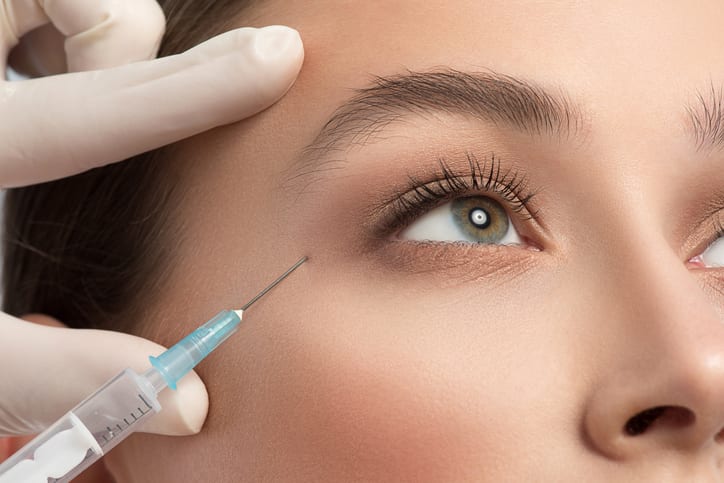How Can Botox ® Improve Your Vision?
Botox ® is commonly known as a cosmetic treatment that removes wrinkles, crow’s feet, dimples, and other lines in your face. The Food and Drug Administration (FDA) approved Botox Cosmetic for these uses in the United States in 2002. What you may not know is that the same injection was first approved in 1989 for medical purposes like uncontrolled muscle spasms. Physicians and eye doctors have been using it to treat eye conditions that are primarily caused by eye muscles for over 20 years. Continue reading to learn more about the injections, how it improves your vision, and what eye conditions the injection can positively affect.
Understanding What Botox ® Is
Botox ® is a shortened name for onabotulinumtoxinA. An injection contains botulinum toxin type A (it’s active ingredient), human albumin and sodium chloride. When it’s is injected into muscles, the toxin prevents nerves from sending signals to the muscles, paralyzing them. Eventually, the nerves regain their ability to send signals, but it takes a few months for them to make new connections to the muscles. That’s why, in many cases, repeat injections are required.
How Can It Improve Your Vision?
Each eye has six muscles – two of which are used to keep your gaze straight by pulling the eye in opposite directions with equal strength. When one of these muscles grows weaker or stronger than the other, one of your eyes will be pulled in the opposite direction causing crossed eyes. When injected into the stronger eye muscle, it relaxes and gives the other eye muscle the opportunity to become equal in strength.
Three Eye Conditions It Treats
The FDA approved Botox ® to treat strabismus (crossed eyes) and diplopia (blurred vision). It has also been used to help patients with blepharospasms (eyelid spasms).
1. Strabismus (Crossed Eyes)
As early as 1970, it has proven to be both a safe and successful treatment for altering the position of the eye of patients with crossed eyes. Typically, within 24-48 hours, the prescribed injection begins to relax the muscles. The greatest muscle weakening usually takes place about two weeks after injection. The muscles resume their original functional state after three months due to the muscle’s ability to create new receptors to restores the signal from the nerve to the muscle.
The procedure for treating Strabismus involves numbing the eye with drops. Once anesthetized, the ophthalmologist uses a special needle connected to an electromyogram (EMG). When the patient moves the eye, the muscle contracts. The EMG picks up the signal from the contracting muscle verifying that the needle is in the correct position. An extremely small amount (typically 0.1ml) is injected into the muscle. The needle remains in place for 30 seconds to minimize the spread of the injection to surrounding tissues.
When the procedure is used to remedy the condition in a child, treatment is carried out either under a general anesthetic or using a ketamine anesthetic. Ketamine anesthetics allow the eye muscles to remain active and the EMG is used to locate the muscle, like an adult procedure. When a general anesthetic is used, a small opening is made in the conjunctiva beside the muscle so the surgeon can see where to inject. With a small opening, no stitches are needed.
2. Diplopia (Blurred Vision)
In some cases of Diplopia (double vision), the use of Botox ® is an effective treatment. This condition can be present in one eye or both. When the condition exists in one eye, it is clinically referred to as monocular diplopia. If the condition affects both eyes, it’s referred to as binocular diplopia.
Your muscles control eye movement and keep the eyes aligned. If a muscle in one eye is weak, it doesn’t move in sync with the healthy eye. You see double when you look in a direction controlled by the weak muscle.
A variety of disorders that affect that nerves of the eyes can cause binocular diplopia. Your ophthalmologist is trained to detect the cause as well as treat the symptom of double vision. Regardless of the cause, Botox ® can “rebalance” the muscles of the eyes and correct the double vision.
Like the treatment for Strabismus (Crossed Eyes), Botox ® is injected into the stronger muscle to relax it, giving the weaker muscle a chance to recover.
3. Blepharospasms (Eyelid Spasms)
Abnormal blinking of the eye or uncontrollable eye muscle contractions can refer to a variety of conditions including eyelid tics, twitches, dry eyes, etc. One form of this condition is called Benign Essential Blepharospasm (BEB). Benign signifies that the condition is not life threatening and “essential” refers to a medical term meaning “of unknown cause”. The visual difficulty causes the forced closure of the eyelids and not from an underlying condition.
Botox ® has been an effective treatment of individuals troubled with Benign Essential Blepharospasm (BEB) for over 25 years, having received FDA approval in 1989. By relaxing the appropriate muscles, doctors are successful at relieving the spasms in most individuals. Improvement is seen within the first two weeks of the injection and can last up to four months.
Injection sites vary depending upon the individuals reported symptoms and the consultation of a skilled ophthalmologist. These symptoms determine the site of injection(s) and typically involve furrowing around the eyebrows. Injections under the skin of the upper lids are generally more effective.

Contact Florida Eye Today For A Consultation
If you suffer from crossed eyes, blurred vision or eyelid spasms, contact our office to schedule an eye exam with our ophthalmologists who have specialized training in these problems. You can learn more about the services offered at Florida Eye on our website. You can also view our physician’s profiles before your visit. As with all treatments, you should consult a professional beforehand to ensure safety and effectiveness.



